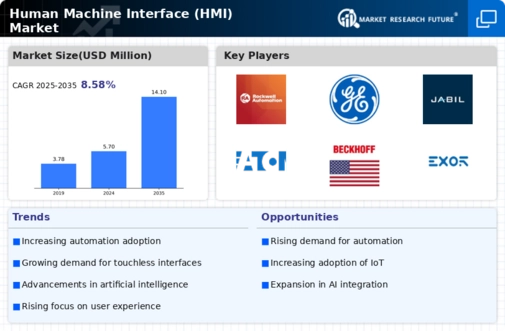Market Trends
Key Emerging Trends in the Human Machine Interface Market
The Human Machine Interface (HMI) market is seeing some notable trends that are impacting its development path and the way humans connect with machines. One noticeable trend is the growing acceptance of touchless and gesture interfaces. Given the stress placed on hygiene and the need to minimize physical contact, touchless HMI solutions have been firmly embraced. Gesture recognition technology gives people the ability to control machines without having direct physical contact, a convenient and cleaner experience. The trend is particularly conspicuous in public places, medical environments and manufacturing areas where it's important to reduce touch points. The rise of augmented reality (AR) and virtual reality interfaces is another interesting trend in the HMI market. These technologies are changing the way humans interact with machines, from embedding digital information in the physical world to recreating immersive virtual environments. AR-based HMI displays real time data and instructions within the user's field of vision, improving decision making while boosting efficiency. Unlike AR, though, VR creates artificial environments for training and design. It can even be used to control robots remotely. But with technologies like AR and VR gaining ever wider popularity, industries are beginning to use these in their HMI implementations as a more human-centered experience. Another important trend influencing the HMI market is the combination of artificial intelligence and machine learning. HMI systems powered by AI can adjust to user needs, learn from the behavior of their users and continuously get better. With natural language processing (NLP), machines can even interact with users through spoken commands via voice-controlled interfaces. AI-driven analytics improve data processing and decision making, bringing important insight to operators. This trend not only makes HMI systems smarter, it also aids predictive maintenance in reducing downtime and improving overall system dependability. Also, modular and tailor-made HMI solutions are becoming increasingly popular. Industries are demanding flexible interfaces that can be flexibly adapted to their own respective needs and workflows. Modular HMI designs that easily accommodate new features and functionalities mean there is no need to redesign the entire system. The recognition that different industries and applications have special needs was an important reason for this trend. A single solution may not be right in all places. Flexible HMI solutions are needed to meet the different requirements of various industries from manufacturing, healthcare and transportation through smart cities.








Leave a Comment